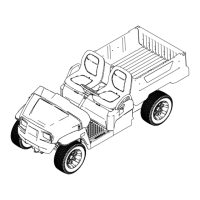Important: Loss of steering control or the
machine may tip over if you position the
load behind the rear axle and the traction
on the front tires is reduced.
• Use extra caution when transporting oversized
loads in the cargo bed, particularly when you
cannot center the weight of the oversize load to
the cargo bed.
• Whenever possible, secure the load by binding it
to the cargo bed so that it does not shift.
• When transporting liquids, use caution when
driving the machine uphill or downhill, when
suddenly changing speed or stopping, or when
driving over rough surfaces.
The capacity of the cargo bed is 0.28 m
3
(10 ft
3
).
The amount (volume) of material that you can place
in the bed without exceeding the load ratings of the
machine can vary greatly depending on the density
of the material.
Refer to the following table for load volume limits with
various materials:
Material Density
Maximum Cargo
Bed Capacity
(on level ground)
Gravel, dry 1522 kg/m
3
(95
lb/ft
3
)
Full
Gravel, wet 1922 kg/m
3
(120
lb/ft
3
)
3/4 Full
Sand, dry 1442 kg/m
3
(90
lb/ft
3
)
Full
Sand, wet 1922 kg/m
3
(120
lb/ft
3
)
3/4 Full
W ood
721 kg/m
3
(45 lb/ft
3
)
Full
Bark
<721 kg/m
3
(<45
lb/ft
3
)
Full
Earth, packed
1602 kg/m
3
(100
lb/ft
3
)
3/4 Full
(approximately)
After Operation
After Operation Safety
General Safety
• Before you leave the operating position, do the
following:
– Park the machine on a level surface.
– Engage the parking brake.
– Shut of f the machine and remove the key .
– W ait for all movement to stop.
• Allow the machine to cool before adjusting,
servicing, cleaning, or storing it.
• Do not store the machine where there is an open
ame, spark, or pilot light, such as on a water
heater or other appliance.
• Keep all parts of the machine in good working
condition and all hardware tightened.
• Maintain and clean the seat belt(s) as necessary .
• Replace all worn, damaged, or missing decals.
Battery and Charger Safety
General
• W ARNING: Risk of re and electric shock—The
batteries have no user-serviceable parts.
• Conrm the voltage that is available in your
country before using the charger .
• Do not get the charger wet; keep it protected from
rain and snow .
• A risk of re, electric shock, or injury may result
from using an accessory not recommended or
sold by T oro.
• T o reduce risk of a battery explosion, follow these
instructions and the instructions for any equipment
that you intend to use near the charger .
• Batteries could emit explosive gasses if they are
signicantly overcharged.
• Refer to an authorized T oro distributor to service
or replace a battery .
T raining
• Never allow children or untrained people to
operate or service the charger . Local regulations
may restrict the age of the operator . The owner
is responsible for training all operators and
mechanics.
• Read, understand, and follow all instructions on
the charger and in the manual before operating
the charger . Be familiar with the proper use of the
charger .
Preparation
• Keep bystanders and children away while
charging.
• W ear appropriate clothing while charging,
including eye protection; long pants; and
substantial, slip-resistant footwear .
• Shut of f the machine and wait until the machine
has completely powered down before charging.
Failure to do this may cause arcing.
• Ensure that the area is well ventilated while
charging.
• The charger is for use on only nominal 120 to
240 V AC operation. For use with 240 V circuits,
contact your authorized T oro distributor for the
correct power cord.
25

